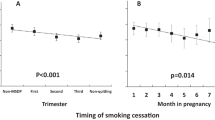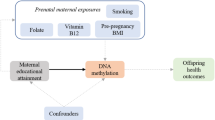Abstract
We examined whether maternal educational level as an indicator of socioeconomic status is associated with gestational hypertension. We also examined the extent to which the effect of education is mediated by maternal substance use (that is smoking, alcohol consumption and illegal drug use), pre-existing diabetes, anthropometrics (that is height and body mass index (BMI)) and blood pressure at enrolment. This was studied in 3262 Dutch pregnant women participating in the Generation R Study, a population-based cohort study. Level of maternal education was established by questionnaire at enrolment, and categorized into high, mid-high, mid-low and low. Diagnosis of gestational hypertension was retrieved from medical records using standard criteria. Odds ratios (OR) of gestational hypertension for educational levels were calculated, adjusted for potential confounders and additionally adjusted for potential mediators. Adjusted for age and gravidity, women with mid-low (OR: 1.52; 95% CI: 1.02, 2.27) and low education (OR: 1.30; 95% CI: 0.80, 2.12) had a higher risk of gestational hypertension than women with high education. Additional adjustment for substance use, pre-existing diabetes, anthropometrics and blood pressure at enrolment attenuated these ORs to 1.09 (95% CI: 0.70, 1.69) and 0.89 (95% CI: 0.50, 1.58), respectively. These attenuations were largely due to the effects of BMI and blood pressure at enrolment. Women with relatively low educational levels have a higher risk of gestational hypertension, which is largely due to higher BMI and blood pressure levels from early pregnancy. The higher risk of gestational hypertension in these women is probably caused by pre-existing hypertensive tendencies that manifested themselves during pregnancy.
This is a preview of subscription content, access via your institution
Access options
Subscribe to this journal
Receive 12 digital issues and online access to articles
$119.00 per year
only $9.92 per issue
Buy this article
- Purchase on Springer Link
- Instant access to full article PDF
Prices may be subject to local taxes which are calculated during checkout

Similar content being viewed by others
References
Hauth JC, Ewell MG, Levine RJ, Esterlitz JR, Sibai B, Curet LB et al. Pregnancy outcomes in healthy nulliparas who developed hypertension. Calcium for Preeclampsia Prevention Study Group. Obstet Gynecol 2000; 95: 24–28.
Villar J, Carroli G, Wojdyla D, Abalos E, Giordano D, Ba’aqeel H et al. Preeclampsia, gestational hypertension and intrauterine growth restriction, related or independent conditions? Am J Obstet Gynecol 2006; 194: 921–931.
Groom KM, North RA, Poppe KK, Sadler L, McCowan LM . The association between customised small for gestational age infants and pre-eclampsia or gestational hypertension varies with gestation at delivery. BJOG 2007; 114: 478–484.
Alexander JM, McIntire DD, Leveno KJ, Cunningham FG . Selective magnesium sulfate prophylaxis for the prevention of eclampsia in women with gestational hypertension. Obstet Gynecol 2006; 108: 826–832.
Xiong X, Demianczuk NN, Saunders LD, Wang FL, Fraser WD . Impact of preeclampsia and gestational hypertension on birth weight by gestational age. Am J Epidemiol 2002; 155: 203–209.
Solomon CG, Seely EW . Brief review:hypertension in pregnancy. A manifestation of the insulin resistance syndrome? Hypertension 2001; 37: 232–239.
Smith GC, Pell JP, Walsh D . Pregnancy complications and maternal risk of ischaemic heart disease: a retrospective cohort study of 129 290 births. Lancet 2001; 357: 2002–2006.
Wilson BJ, Watson MS, Prescott GJ, Sunderland S, Campbell DM, Hannaford P et al. Hypertensive diseases of pregnancy and risk of hypertension and stroke in later life: results from cohort study. BMJ 2003; 326: 845–849.
Ohkuchi A, Iwasaki R, Suzuki H, Hirashima C, Takahashi K, Usui R et al. Normal and high-normal blood pressures, but not body mass index, are risk factors for the subsequent occurrence of both preeclampsia and gestational hypertension: a retrospective cohort study. Hypertens Res 2006; 29: 161–167.
England LJ, Levine RJ, Qian C, Morris CD, Sibai BM, Catalano PM et al. Smoking before pregnancy and risk of gestational hypertension and preeclampsia. Am J Obstet Gynecol 2002; 186: 1035–1040.
Marcoux S, Brisson J, Fabia J . The effect of cigarette smoking on the risk of preeclampsia and gestational hypertension. Am J Epidemiol 1989; 130: 950–957.
Loucks EB, Rehkopf DH, Thurston RC, Kawachi I . Socioeconomic disparities in metabolic syndrome differ by gender: evidence from III NHANES. Ann Epidemiol 2007; 17: 19–26.
Mackenbach JP, Cavelaars AE, Kunst AE, Groenhof F . Socioeconomic inequalities in cardiovascular disease mortality; an international study. Eur Heart J 2000; 21: 1141–1151.
Vargas CM, Ingram DD, Gillum RF . Incidence of hypertension and educational attainment: the NHANES I epidemiologic followup study. First National Health and Nutrition Examination Survey. Am J Epidemiol 2000; 152: 272–278.
Davies AM, Czaczkes JW, Sadovsky E, Prywes R, Weiskopf P, Sterk VV . Toxemia of pregnancy in Jerusalem. I. Epidemiological studies of a total community. Isr J Med Sci 1970; 6: 253–266.
Haelterman E, Qvist R, Barlow P, Alexander S . Social deprivation and poor access to care as risk factors for severe pre-eclampsia. Eur J Obstet Gynecol Reprod Biol 2003; 111: 25–32.
Nelson TR . A clinical study of pre-eclampsia. I. J Obstet Gynaecol Br Emp 1955; 62: 48–57.
Lawlor DA, Morton SM, Nitsch D, Leon DA . Association between childhood and adulthood socioeconomic position and pregnancy induced hypertension: results from the Aberdeen children of the 1950s cohort study. J Epidemiol Community Health 2005; 59: 49–55.
Clausen T, Oyen N, Henriksen T . Pregnancy complications by overweight and residential area. A prospective study of an urban Norwegian cohort. Acta Obstet Gynecol Scand 2006; 85: 526–533.
Saftlas AF, Logsden-Sackett N, Wang W, Woolson R, Bracken MB . Work, leisure-time physical activity, and risk of preeclampsia and gestational hypertension. Am J Epidemiol 2004; 160: 758–765.
Hofman A, Jaddoe VW, Mackenbach JP, Moll HA, Snijders RF, Steegers EA et al. Growth, development and health from early fetal life until young adulthood: the Generation R Study. Paediatr Perinat Epidemiol 2004; 18: 61–72.
Winkleby MA, Jatulis DE, Frank E, Fortmann SP . Socioeconomic status and health: how education, income, and occupation contribute to risk factors for cardiovascular disease. Am J Public Health 1992; 82: 816–820.
Tanaka M, Jaamaa G, Kaiser M, Hills E, Soim A, Zhu M et al. Racial disparity in hypertensive disorders of pregnancy in New York State: a 10-year longitudinal population-based study. Am J Public Health 2007; 97: 163–170.
Jaddoe VW, Mackenbach JP, Moll HA, Steegers EA, Tiemeier H, Verhulst FC et al. The Generation R Study: design and cohort profile. Eur J Epidemiol 2006; 21: 475–484.
Statistics Netherlands. Migrants in the Netherlands 2004 (Allochtonen in Nederland 2004). Voorburg/Heerlen 2004. http://www.cbs.nl.
Statistics Netherlands. Standard classification of education 2003 (Standaard onderwijsindeling 2003). Voorburg/Heerlen 2004. http://www.cbs.nl.
Brown MA, Lindheimer MD, de Swiet M, Van Assche A, Moutquin JM . The classification and diagnosis of the hypertensive disorders of pregnancy: statement from the International Society for the Study of Hypertension in Pregnancy (ISSHP). Hypertens Pregnancy 2001; 20: IX–XIV.
McNamee R . Confounding and confounders. Occup Environ Med 2003; 60: 227–234; quiz 164, 234.
El Assaad MA, Topouchian JA, Darne BM, Asmar RG . Validation of the Omron HEM-907 device for blood pressure measurement. Blood Press Monit 2002; 7: 237–241.
MacKinnon DP, Krull JL, Lockwood CM . Equivalence of the mediation, confounding and suppression effect. Prev Sci 2000; 1: 173–181.
Victora CG, Huttly SR, Fuchs SC, Olinto MT . The role of conceptual frameworks in epidemiological analysis: a hierarchical approach. Int J Epidemiol 1997; 26: 224–227.
Patja K, Jousilahti P, Hu G, Valle T, Qiao Q, Tuomilehto J . Effects of smoking, obesity and physical activity on the risk of type 2 diabetes in middle-aged Finnish men and women. J Intern Med 2005; 258: 356–362.
Omvik P . How smoking affects blood pressure. Blood Press 1996; 5: 71–77.
Lynch J, Kaplan GA . Socioeconomic position. In: Berkman LF, Kawachi I (eds). Social Epidemiology, 1st edn. Oxford University Press: Oxford, 2000, pp 13–35.
Braveman PA, Cubbin C, Egerter S, Chideya S, Marchi KS, Metzler M et al. Socioeconomic status in health research: one size does not fit all. JAMA 2005; 294: 2879–2888.
Galobardes B, Shaw M, Lawlor DA, Lynch JW, Davey Smith G . Indicators of socioeconomic position (part 1). J Epidemiol Community Health 2006; 60: 7–12.
Center for Research and Statistics, Rotterdam (COS),. 2005:Center for Research and Statistics, Rotterdam (COS) http://www.cos.rotterdam.nl; 2005.
Tubbergen P, Lachmeijer AM, Althuisius SM, Vlak ME, van Geijn HP, Dekker GA . Change in paternity: a risk factor for preeclampsia in multiparous women? J Reprod Immunol 1999; 45: 81–88.
Colhoun HM, Hemingway H, Poulter NR . Socio-economic status and blood pressure: an overview analysis. J Hum Hypertens 1998; 12: 91–110.
Hermida RC, Ayala DE, Iglesias M . Predictable blood pressure variability in healthy and complicated pregnancies. Hypertension 2001; 38: 736–741.
Gillman MW, Cook NR, Evans DA, Rosner B, Hennekens CH . Relationship of alcohol intake with blood pressure in young adults. Hypertension 1995; 25: 1106–1110.
Zhang J, Klebanoff MA, Levine RJ, Puri M, Moyer P . The puzzling association between smoking and hypertension during pregnancy. Am J Obstet Gynecol 1999; 181: 1407–1413.
Janzon E, Hedblad B, Berglund G, Engstrom G . Changes in blood pressure and body weight following smoking cessation in women. J Intern Med 2004; 255: 266–272.
Chesley LC . Hypertension in pregnancy: definitions, familial factor, and remote prognosis. Kidney Int 1980; 18: 234–240.
Franklin SS, Pio JR, Wong ND, Larson MG, Leip EP, Vasan RS et al. Predictors of new-onset diastolic and systolic hypertension: the Framingham Heart Study. Circulation 2005; 111: 1121–1127.
Acknowledgements
The Generation R Study is conducted by Erasmus MC, University Medical Centre Rotterdam in close collaboration with the Erasmus University Rotterdam School of Law and Faculty of Social Sciences, the Municipal Health Service for the Rotterdam area, the Rotterdam Homecare Foundation, Rotterdam and the Stichting Trombosedienst & Artsenlaboratorium Rijnmond (STAR), Rotterdam. We gratefully acknowledge the contribution of general practitioners, hospitals, midwives and pharmacies in Rotterdam. The first phase of the Generation R Study was made possible by financial support from Erasmus MC, University Medical Centre Rotterdam, Erasmus University Rotterdam and the Netherlands Organization for Health Research and Development (ZonMw). The present study was supported by an additional grant from the Netherlands Organization for Scientific Research (NWO, grant no 017.002.107).
Author information
Authors and Affiliations
Corresponding author
Rights and permissions
About this article
Cite this article
Silva, L., Coolman, M., Steegers, E. et al. Maternal educational level and risk of gestational hypertension: the Generation R Study. J Hum Hypertens 22, 483–492 (2008). https://doi.org/10.1038/jhh.2008.22
Received:
Revised:
Accepted:
Published:
Issue Date:
DOI: https://doi.org/10.1038/jhh.2008.22
Keywords
This article is cited by
-
Secondhand smoke exposure is associated with the risk of hypertensive disorders of pregnancy: the Japan Environment and Children’s Study
Hypertension Research (2023)
-
A global view of hypertensive disorders and diabetes mellitus during pregnancy
Nature Reviews Endocrinology (2022)
-
Mediators of differences by parental education in weight-related outcomes in childhood and adolescence in Norway
Scientific Reports (2022)
-
Urban social environment and low birth weight in 360 Latin American cities
BMC Public Health (2021)
-
Evaluation of neonatal and maternal morbidity in mothers with gestational diabetes: a population-based study
BMC Pregnancy and Childbirth (2018)



